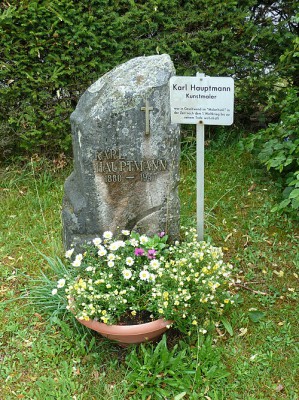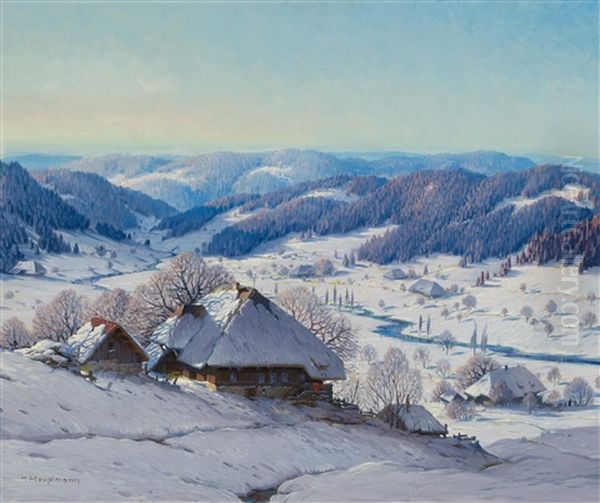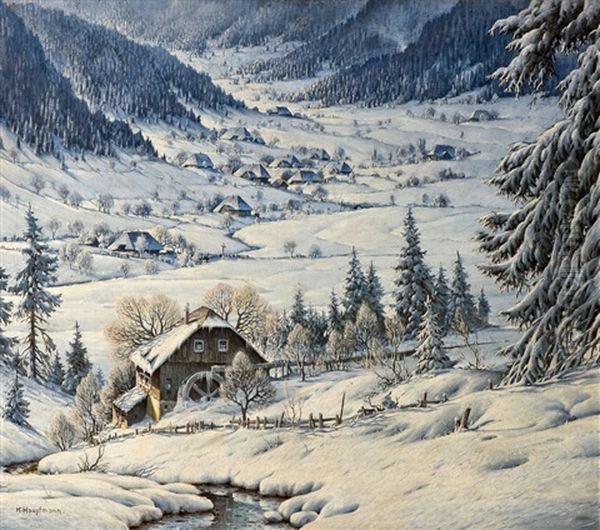
Karl Hauptmann, a German painter whose life spanned from 1880 to 1947, dedicated much of his artistic career to capturing the unique landscapes and enduring spirit of the Black Forest (Schwarzwald) region. Working primarily in oils, he developed a style that blended realistic observation with a deeply felt romantic sensibility, creating evocative images of a specific German landscape undergoing gradual change. His works serve as both aesthetic documents and nostalgic reflections of a particular place and time.
Hauptmann's nationality was German, and his primary areas of activity were indeed Germany, particularly the southwestern region encompassing the Black Forest, and also Switzerland. While details of his early life and comprehensive training require further clarification beyond the scope of easily accessible records, his mature work firmly establishes his identity as a landscape painter deeply connected to the Schwarzwald.
His commitment to this region suggests an intimate knowledge and profound appreciation for its topography, architecture, and the distinct atmosphere created by its dense forests, rolling hills, and changing seasons. Switzerland, geographically close and sharing alpine characteristics, likely offered further inspiration or opportunities for study and work, contributing to his development as a landscape artist.
The Enduring Subject: The Black Forest
The Black Forest was unequivocally the central theme of Karl Hauptmann's artistic output. His canvases repeatedly explore this renowned region, famous for its dense evergreen forests, picturesque valleys, traditional farmhouses, and distinct cultural identity. Hauptmann seemed particularly drawn to the interplay of nature and human settlement within this environment.
He painted the Schwarzwald throughout the year, capturing its diverse moods. His works often feature the characteristic timber-framed farmhouses (Schwarzwaldhöfe), nestled in valleys or perched on hillsides. These structures are not mere architectural elements but symbols of a traditional way of life, representing resilience and continuity amidst the natural world.
Hauptmann depicted the changing seasons with sensitivity. Spring might be shown with blossoming trees and fresh green meadows, while autumn scenes could focus on the rich colours of the foliage or the harvest. However, he is perhaps best known for his evocative winter landscapes, capturing the deep snows that blanket the region, transforming familiar scenes into quiet, almost magical realms.

Weather also played a significant role in his compositions. He painted calm, sunny days, but also captured the drama of approaching storms, adding a dynamic element to the otherwise tranquil scenery. Through his focused lens on the Black Forest, Hauptmann created a comprehensive visual record of its enduring appeal.
Artistic Style: Realism Meets Romanticism
Karl Hauptmann's artistic style is best characterized as a fusion of Naturalism and Romanticism. His approach was grounded in careful observation of the natural world. The details of the landscape, the structure of the farmhouses, the quality of light at different times of day – these elements are rendered with a commitment to realistic representation.
However, Hauptmann elevated his depictions beyond mere documentation. He infused his scenes with a palpable atmosphere, often tinged with nostalgia or a sense of timelessness. This romantic sensibility is particularly evident in his treatment of light and colour. He often employed warm palettes, even in winter scenes, creating a feeling of coziness and shelter despite the cold.
His compositions are typically well-balanced, guiding the viewer's eye through the landscape. While grounded in reality, there's often an idealized quality to his work, emphasizing the beauty and harmony of the Schwarzwald. He seemed less interested in the radical formal experiments of modernism that were happening concurrently during his lifetime.
Compared to the French Impressionists like Claude Monet or Camille Pissarro, Hauptmann's brushwork appears generally tighter and more descriptive, though he certainly paid attention to capturing light effects. His work doesn't delve into the intense subjectivity and bold colour distortions of German Expressionists like Ernst Ludwig Kirchner or Emil Nolde. Instead, he remained closer to a tradition of German landscape painting that valued both accuracy and emotional resonance.
Representative Masterpieces
Among Karl Hauptmann's known works, several stand out as exemplars of his style and thematic concerns. Two frequently cited paintings provide insight into his artistic vision:

_Schneebedeckter Schwarzwaldhof bei aufziehendem Gewitter_ (Snow-Covered Black Forest Farm Under an Approaching Thunderstorm), 1923: This painting encapsulates many key elements of Hauptmann's work. It depicts a traditional Black Forest farmstead blanketed in heavy snow, a recurring motif for the artist. The realism is evident in the rendering of the building's architecture and the texture of the snow. However, the title element – the approaching thunderstorm – introduces dramatic tension. The contrast between the tranquil, snow-covered scene and the impending atmospheric disturbance creates a powerful mood, blending the picturesque with a hint of nature's untamed power. It showcases his ability to capture specific weather conditions and their impact on the landscape.
_Frühling im Schwarzwald_ (Spring in the Black Forest), 1946: Painted towards the end of his life, this work likely reflects a continued engagement with his beloved subject. As the title suggests, it captures the Schwarzwald during its period of renewal. One can imagine depictions of budding trees, vibrant green pastures, and perhaps the characteristic farmhouses bathed in the clearer light of spring. This work would contrast with his winter scenes, highlighting the cyclical nature of the seasons and the enduring beauty of the region across different times of the year. It likely embodies the more lyrical and perhaps hopeful side of his romantic-realist style.
These works, alongside others focusing on autumnal scenes or different aspects of Black Forest life, solidify Hauptmann's reputation as a dedicated visual interpreter of this specific German landscape.
Context: Hauptmann and His Contemporaries
Karl Hauptmann worked during a dynamic period in German art history. While he pursued his own path focused on the Black Forest, his life overlapped with numerous significant artists and movements. Placing him in context requires acknowledging these figures, even if direct documented interactions with Hauptmann the painter are scarce.
One crucial figure for comparison is Hans Thoma (1839-1924). Thoma, though of an earlier generation, was profoundly associated with the Black Forest and achieved great popularity for his depictions of its landscapes and people, often imbued with a sense of idyllic simplicity and German identity. Hauptmann’s work can be seen as continuing this tradition of regional landscape painting, albeit with his own stylistic nuances.
The late 19th and early 20th centuries saw the rise of German Impressionism, spearheaded by artists like Max Liebermann (1847-1935), Lovis Corinth (1858-1925), and Max Slevogt (1868-1932). While Hauptmann was their contemporary, his style generally remained more conservative and less focused on the fleeting effects of light and broken brushwork characteristic of Impressionism. Liebermann, for instance, tackled a wider range of subjects, including urban life and portraiture, alongside landscapes.
Realism also had strong proponents in Germany, such as Wilhelm Leibl (1844-1900) and his circle, known for their unvarnished depictions of rural life. While Hauptmann shared an interest in rural subjects, his approach often carried a stronger romantic or idealized undercurrent compared to Leibl's starker realism. Artists like Fritz von Uhde (1848-1911) and Wilhelm Trübner (1851-1917) also navigated the currents between Realism and Impressionism.
The artists' colony at Worpswede, near Bremen, produced notable landscape painters like Otto Modersohn (1865-1943) and Paula Modersohn-Becker (1876-1907). While geographically distant from the Black Forest, their focus on specific German landscapes and rural life offers a parallel to Hauptmann's work, though Modersohn-Becker moved towards a more expressive, proto-Expressionist style.
Hauptmann also worked during the rise of German Expressionism, with groups like Die Brücke (The Bridge) and Der Blaue Reiter (The Blue Rider). Figures such as Ernst Ludwig Kirchner (1880-1938), Franz Marc (1880-1916), and August Macke (1887-1914) – exact contemporaries by birth year in Kirchner's and Marc's cases – were revolutionizing German art with bold colours, distorted forms, and intense emotional expression. Hauptmann’s art stands apart from this avant-garde movement, representing a continuation of more traditional landscape painting modes.
Even earlier influences, like the profound Romantic landscapes of Caspar David Friedrich (1774-1840), might be seen as part of the broader cultural background against which later German landscape painters, including Hauptmann, developed their visions of nature and its spiritual or emotional significance. Other contemporaries like Leo Putz (1869-1940), associated with the Munich Secession and Jugendstil, explored decorative landscape styles that also differed from Hauptmann's focus.
While specific records of Karl Hauptmann's interactions with these painters may be limited, understanding the diverse artistic environment in which he worked helps to define his specific contribution – that of a dedicated regionalist painter blending realism with romantic feeling.
Legacy and Art Historical Standing
Karl Hauptmann's position in art history is primarily that of a significant regional painter, deeply associated with the Black Forest. He is not typically counted among the major innovators or avant-garde figures of German art in the tumultuous first half of the 20th century. His adherence to a more traditional, romantic-realist style set him apart from the dominant modernist currents of Expressionism or later abstraction.
However, his dedication to a specific landscape and his skill in capturing its characteristic features and atmosphere have earned him lasting recognition within the field of German landscape painting. His works are appreciated for their technical competence, their evocative mood, and their documentation of the Schwarzwald's natural beauty and traditional architecture.
His paintings, particularly the snow scenes and depictions of farmhouses, remain popular with collectors interested in German art, regional landscapes, and traditional subjects. Auction records and gallery inventories confirm a continued market presence for his work, indicating an enduring appeal that transcends art historical categorization alongside major movements.
It is important to distinguish Karl Hauptmann the painter (1880-1947) from his near-contemporary, the highly famous German playwright and Nobel laureate Gerhart Hauptmann (1862-1946), and also from Gerhart's brother, the writer Carl Hauptmann (1858-1921). While sharing a surname and German nationality, Karl Hauptmann the painter occupies a distinct place focused on the visual arts and landscape depiction.
His legacy lies in his consistent and affectionate portrayal of the Black Forest. He provided a visual counterpart to the region's literary and cultural identity, capturing a sense of place that resonated with contemporaries and continues to find appreciation. He stands as a testament to the enduring value of representational landscape painting focused on conveying the character and spirit of a specific locale.
Conclusion: A Painter of Place
Karl Hauptmann (1880-1947) carved a distinct niche for himself within German art as a devoted painter of the Black Forest. Through decades of work, he explored its valleys, forests, and farmsteads, capturing the changing seasons and the interplay of light and weather. His style, a blend of careful realistic observation and a pervasive romantic sensibility, allowed him to create images that were both descriptive and deeply atmospheric. While not aligned with the major avant-garde movements of his time, his work holds a significant place as a visual chronicle of one of Germany's most iconic regions. His paintings continue to be valued for their artistic merit and their evocative portrayal of the timeless, yet subtly changing, character of the Schwarzwald.